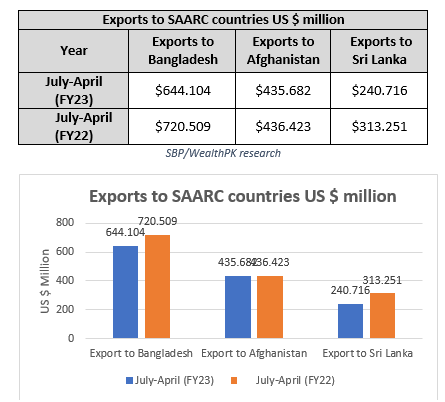INP-WealthPk
Arsalan Ali
Pakistan exported $1,330.037 million worth of goods to the SAARC countries during the first 10 months (July-April) of the current fiscal year (FY22-23), making 5.6% of the total exports, reports WealthPK quoting the data released by the State Bank of Pakistan. The exports could be enhanced by signing a regional trade agreement (RTA) with the countries in the region and reducing the trade barriers. Among the SAARC nations, the majority of exports were directed towards Bangladesh (48.42%), followed by Afghanistan (32.75%), and Sri Lanka (18.09%). On the other hand, a minimal share of exports reached Nepal, Maldives, Bhutan, and India.
Muhammad Zeeshan, a research fellow at the Pakistan Institute of Development Economics, told WealthPK that reducing tariffs can have a positive impact on the overall trade among the SAARC countries. He said Pakistan had an average import tariff rate of around 12%, adding that tariffs acted as a trade diversion, leading to increased prices of imported goods and reducing consumer demand due to higher prices.
He said having more regional trade agreements (RTAs) among the South Asian countries, such as the South Asian Free Trade Agreement (SAFTA), would yield positive results for Pakistan's total trade and economic growth. Zeeshan said Pakistan had significant trade potential with India and the trade costs between the two countries were minimal because of their proximity. According to the World Bank, trade costs within the South Asia countries are significantly higher than the other regions. The average tariff in South Asia is more than twice the global average. In addition, South Asian countries impose greater trade barriers on imports from within the region compared to imports from the rest of the world.
A study titled "Trade Potential of Pakistan with South Asian Countries," conducted by Nabila Khurshid, a trade expert at the Comsats University Islamabad, highlights that by increasing RTA among the South Asian countries, such as SAFTA, Pakistan's trade could increase by 15.3%. The study emphasizes the pressing need for promoting regional trade because South Asia is particularly vulnerable, being the second-worst affected in terms of poverty after the African region. The study points out that water security and climate change present significant threats to the region's ability to provide sustenance for its inhabitants. Therefore, reducing trade diversion barriers among the participating countries would be highly advantageous in alleviating poverty and unemployment, it adds.
Moreover, as per the SBP data, Pakistan's exports to Bangladesh fell by 22.8% to $55.811 million in April 2023 compared to $72.297 million in April 2022. The total exports to Bangladesh for the July-April FY23 period were $644.104 million, down from $720.509 million during the same period of the last fiscal year, showing a decline of $76.405 million. During this period, a trade surplus of $578.061 million was recorded with Bangladesh.

Exports to Afghanistan declined by 47.7% to $34.911 million in April 2023 compared to $66.798 million in April 2022. However, exports remained stagnant in 10MFY23, reaching $435.682 million compared to $436.423 million during the same period of the previous fiscal year. During this time, a trade surplus of $421.723 million was recorded with Afghanistan. Exports to Sri Lanka fell by 37.1% to $17.861 million in April 2023 compared to $28.429 million in April 2022. The total exports for the July-April period of this fiscal year were $240.716 million, representing a 23.1% decrease from $313.251 million during the same period of the last fiscal year. The trade surplus with Sri Lanka was $199.793 million.

Exports to India, Nepal, Bhutan, and Maldives remained at $0.250 million, $2.454 million, $0.048 million, and $6.783 million, respectively, during 10MFY23 compared to $1.075 million, $5.063 million, $0.075 million, $5.719 million respectively during the same period of the last year.
Credit: Independent News Pakistan-WealthPk




